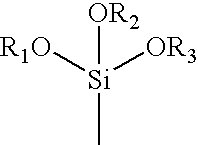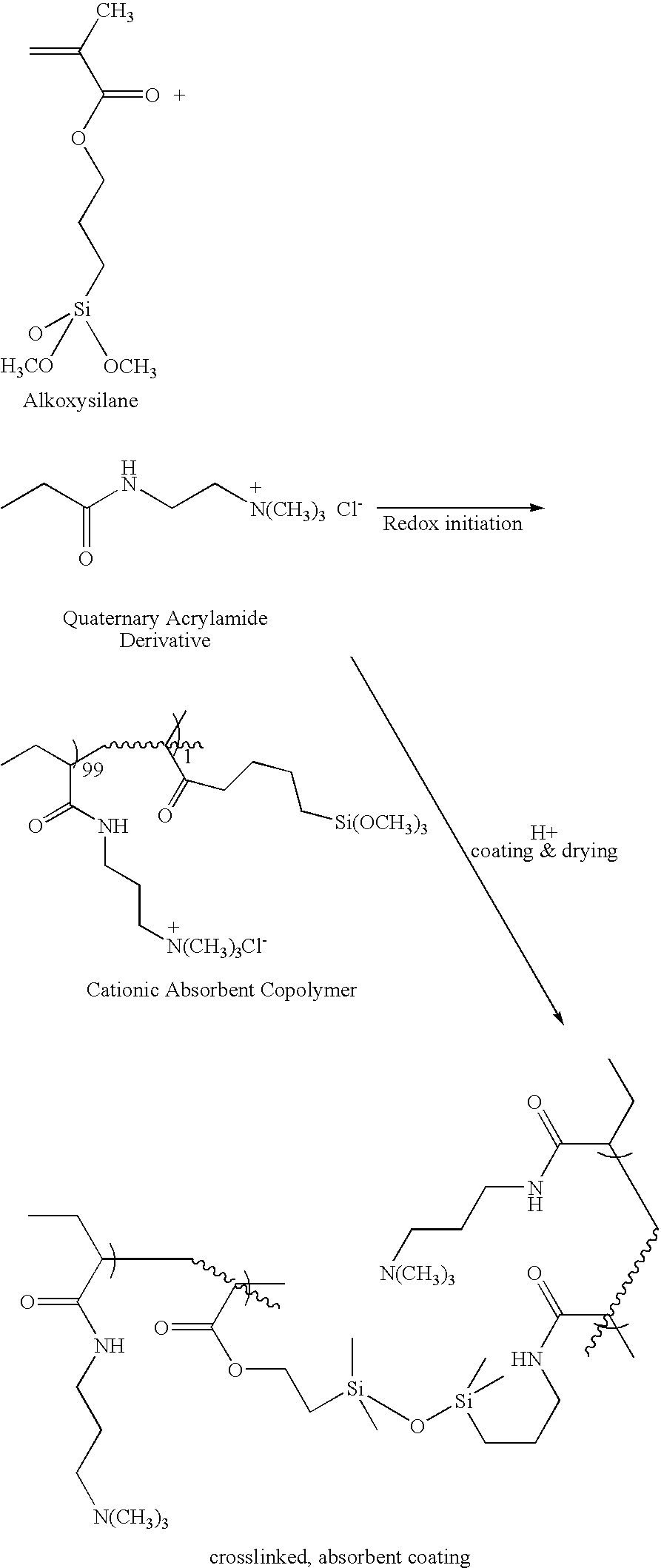Absorbent binder composition and method of making it
a technology of absorbent binder and coating composition, which is applied in the direction of synthetic resin layered products, undergarments, separation processes, etc., can solve the problems of inconvenient liquid transfer function, inconvenient use, and inability to absorb liquids, etc., and achieve high density
- Summary
- Abstract
- Description
- Claims
- Application Information
AI Technical Summary
Benefits of technology
Problems solved by technology
Method used
Image
Examples
example 1
[0074]Two monomer solutions were prepared separately. Solution No. 1 was prepared as follows. To 14.4 grams (0.20 moles) of acrylic acid in a 200 ml beaker was added 33.3 grams of a 18% aqueous solution of polyethylene glycol 8000, followed by a solution of 3.2 grams of sodium hydroxide in 21.4 grams of distilled water. Then, 0.18 grams (1.02×10−3 moles) of ascorbic acid was added to the solution. This mixture was stirred with a magnetic stir bar at about 60 rpm in a bath of water at about 23° C. until the ascorbic acid was dissolved and the mixture cooled to 23° C.
[0075]Solution No. 2 was prepared in the following manner. To 14.4 grams (0.20 moles) of acrylic acid, in a 300 ml beaker was added to 33.3 grams of a 18% aqueous solution of polyethylene glycol 8000 (mol. wt.=8000) followed by a solution of 3.2 grams of sodium hydroxide in 21.4 grams of distilled water, 0.57 ml of 30% aqueous hydrogen peroxide and 1.0 ml (5.42×10−3 moles) of 3-(trimethoxysilyl)propyl methacrylate. The in...
example 2
[0080]An aqueous binder composition was prepared according to the procedure of EXAMPLE 1. This example was used to determine the speed of crosslinking in the following manner. Six 10-cm by 10-cm pieces of loft bonded carded web surge material made according to U.S. Pat. No. 5,364,382, by Kimberly-Clark Corporation, with a basis weight of about 45 gsm and a density of 0.04 g / cm3 measured at a pressure of 0.05 psi, were each immersed in about 12 grams of the binder solution to thoroughly saturate the fabric. The dry weight of each fabric was weighed prior to saturation with the binder solution. The weights of the starting solution and of the residual solution were measured, with the difference being equal to the weight of solution applied to each piece of fabric. The saturated surge sample was placed on an aluminum screen and dried for times ranging from 5 to 15 minutes at 105° C. in a Mathis through-air-dryer oven, available from Werner Mathis in Palmer, Pa. After drying, for the spe...
example 3
[0083]This example relates to the preparation of a cationic absorbent polymer. Two monomer solutions were prepared separately. Solution No. 1 was prepared as follows. To 55.0 grams of a 75% solution of (3-acrylamidopropyl) trimethyl ammonium chloride (0.20 moles) was added 21.3 grams of deionized water, and 6.0 grams of PEG 200 (molecular weight 200). Then, 0.18 grams (1.02×10−3 moles) of ascorbic acid was added to the solution. This mixture was stirred with a magnetic stir bar at about 60 rpm in a bath of water at about 23° C. until the ascorbic acid was dissolved and the mixture cooled to 23° C.
[0084]Solution No. 2 was prepared in the following manner. To 55.0 grams of a 75° C. solution of (3-acrylamidopropyl) trimethyl ammonium chloride (0.20 moles) was added 21.3 grams of deionized water, 6.0 grams of PEG 200 (molecular weight 200), 0.37 ml of 30% aqueous hydrogen peroxide and 1.0 ml (5.42×10−3 moles) of 3-(trimethoxysilyl)propyl methacrylate. This mixture was stirred with a mag...
PUM
| Property | Measurement | Unit |
|---|---|---|
| Temperature | aaaaa | aaaaa |
| Percent by mass | aaaaa | aaaaa |
| Percent by mass | aaaaa | aaaaa |
Abstract
Description
Claims
Application Information
 Login to View More
Login to View More - R&D
- Intellectual Property
- Life Sciences
- Materials
- Tech Scout
- Unparalleled Data Quality
- Higher Quality Content
- 60% Fewer Hallucinations
Browse by: Latest US Patents, China's latest patents, Technical Efficacy Thesaurus, Application Domain, Technology Topic, Popular Technical Reports.
© 2025 PatSnap. All rights reserved.Legal|Privacy policy|Modern Slavery Act Transparency Statement|Sitemap|About US| Contact US: help@patsnap.com



